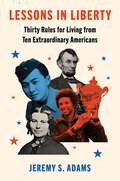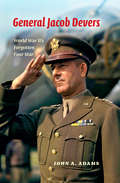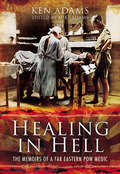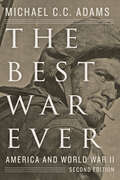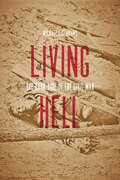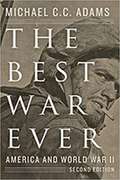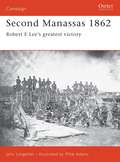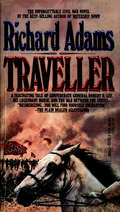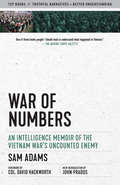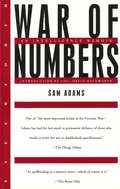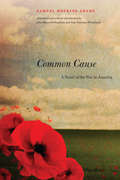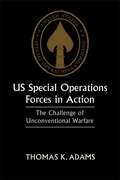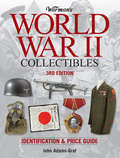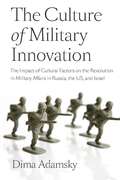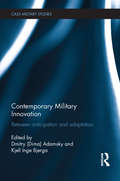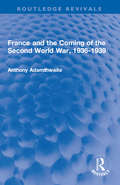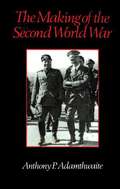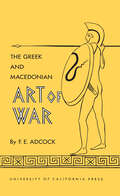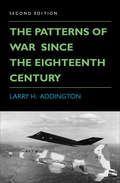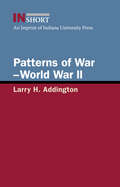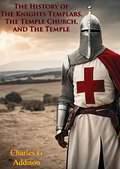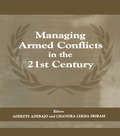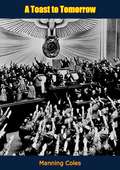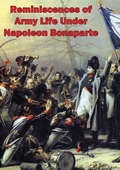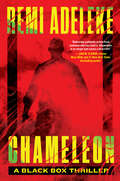- Table View
- List View
Lessons in Liberty: Thirty Rules for Living from Ten Extraordinary Americans
by Jeremy S. Adams“Smart, patriotic, and readable, this book is what our cynical culture needs.” — Pete Hegseth, #1 New York Times bestselling author of Battle for the American MindAmerica is full of inspiring heroes.Greatness is not a chance—it is a choice. George Washington didn’t simply wake up as one of the greatest men in human history. His greatness was the sum of a lifetime of difficult and consequential choices.In Lessons in Liberty, Jeremy S. Adams distills inspiring advice from the lives of extraordinary Americans from our past.George Washington’s lifelong struggle to conquer his temper makes him a model for self-help and self-improvement.Daniel Inouye was a beloved Japanese American senator who carried out daring missions in World War II, despite being subjected to discrimination by the very nation he decided to defend.Eleven-year-old Clara Barton’s role in nursing her injured brother back to health instilled the courage and ferocity that would later empower her to pioneer new nursing techniques during the Civil War.Adams has been an educator for more than a quarter century. Teaching a new generation of students who suffer with anxiety, passivity, and a cynical view of their own nation and its principles has convinced him that a change is urgently needed: The recovery of national greatness requires that we passionately study our heroes. Lessons in Liberty is the first step to discovering the better angels of our nature by restoring the possibilities of individual freedom.In this beautifully written, proudly patriotic, and deeply researched ode to American heroes from a rich variety of eras and backgrounds, Adams reclaims the power of the American story, discovering thirty different and surprising lessons that will inspire modern Americans to lead better and more substantive lives.
General Jacob Devers: World War II's Forgotten Four Star
by John A. AdamsOf the leaders of the American Army in World War II, Jacob Devers is undoubtedly the "forgotten four star." Plucked from relative obscurity in the Canal Zone, Devers was one of four generals selected by General of the Army George Marshall in 1941 to assist him in preparing the Army for war. He quickly became known in Army circles for his "can do" attitude and remarkable ability to cut through red tape. Among other duties, he was instrumental in transforming Ft. Bragg, then a small Army post, into a major training facility. As head of the armored force, Devers contributed to the development of a faster, more heavily armored tank, equipped with a higher velocity gun that could stand up to the more powerful German tanks, and helped to turn American armor into an effective fighting force. In spring 1943, Devers replaced Dwight Eisenhower as commander of the European Theater of Operations, then was given command of the 6th Army Group that invaded the south of France and fought its way through France and Germany to the Austrian border. In the European campaign to defeat Hitler, Eisenhower had three subordinate army group commanders--British Field Marshall Bernard Montgomery, Omar S. Bradley, and Jacob Devers. The first two are well-known--here the third receives the attention he properly deserves.
Healing in Hell: The Memoirs of a Far Eastern POW Medic
by Ken AdamsKen Adams, as a trained medic, was sent out to the Far East and immediately saw action on the Malay Peninsula. Captured at Singapore he initially worked at Changi Hospital. Many moves and much worse capos in Thailand were to follow. He describes his life, work and the terrible conditions endured at the hands of the Japanese and Korea guards and worst of all, the Kempetai secret police.Illnesses such as dysentery, malaria, avitominosis, cholera and smallpox had to be treated with minimal or no medicines. Starvation was a fact of life.The author was frequently moved around and in 1945 took part in a march of many hundreds of miles which inevitably proved fatal to many of his fellow POWs.Liberation and repatriation are movingly described as, most significantly, is the whole process of settling back into normal life after so long in captivity of the worst kind.Healing in Hell is an exceptional account that demands reading.
The Best War Ever: America and World War II (The American Moment)
by Michael C. AdamsThe most readable—and searingly honest—short book ever written on this pivotal conflict.Was World War II really such a "good war"? Popular memory insists that it was, in fact, "the best war ever." After all, we knew who the enemy was, and we understood what we were fighting for. The war was good for the economy. It was liberating for women. A battle of tanks and airplanes, it was a "cleaner" war than World War I. Although we did not seek the conflict—or so we believed—Americans nevertheless rallied in support of the war effort, and the nation's soldiers, all twelve million of them, were proud to fight. But according to historian Michael C. C. Adams, our memory of the war era as a golden age is distorted. It has left us with a misleading—even dangerous—legacy, one enhanced by the nostalgia-tinged retrospectives of Stephen E. Ambrose and Tom Brokaw. Disputing many of our common assumptions about the period, Adams argues in The Best War Ever that our celebratory experience of World War II is marred by darker and more sordid realities. In the book, originally published in 1994, Adams challenges stereotypes to present a view of World War II that avoids the simplistic extremes of both glorification and vilification. The Best War Ever charts the complex diplomatic problems of the 1930s and reveals the realities of ground combat: no moral triumph, it was in truth a brutal slog across a blasted landscape. Adams also exposes the myth that the home front was fully united behind the war effort, demonstrating how class, race, gender, and age divisions split Americans. Meanwhile, in Europe and Asia, shell-shocked soldiers grappled with emotional and physical trauma, rigorously enforced segregation, and rampant venereal disease.In preparing this must-read new edition, Adams has consulted some seventy additional sources on topics as varied as the origins of Social Security and a national health system, the Allied strategic bombing campaign, and the relationship of traumatic brain injuries to the adjustment problems of veterans. The revised book also incorporates substantial developments that have occurred in our understanding of the course and character of the war, particularly in terms of the human consequences of fighting. In a new chapter, "The Life Cycle of a Myth," Adams charts image-making about the war from its inception to the present. He contrasts it with modern-day rhetoric surrounding the War on Terror, while analyzing the real-world consequences that result from distorting the past, including the dangerous idea that only through (perpetual) military conflict can we achieve lasting peace.
Living Hell: The Dark Side of the Civil War
by Michael C. AdamsA senior military historian presents an unflinching account of the human costs of the Civil War.Many Americans, argues Michael C. C. Adams, tend to think of the Civil War as more glorious, less awful, than the reality. Millions of tourists flock to battlefields each year as vacation destinations, their perceptions of the war often shaped by reenactors who work hard for verisimilitude but who cannot ultimately simulate mutilation, madness, chronic disease, advanced physical decay. In Living Hell, Adams tries a different tack, clustering the voices of myriad actual participants on the firing line or in the hospital ward to create a virtual historical reenactment.Perhaps because the United States has not seen conventional war on its own soil since 1865, the collective memory of its horror has faded, so that we have sanitized and romanticized even the experience of the Civil War. Neither film nor reenactment can fully capture the hard truth of the four-year conflict. Living Hell presents a stark portrait of the human costs of the Civil War and gives readers a more accurate appreciation of its profound and lasting consequences.Adams examines the sharp contrast between the expectations of recruits versus the realities of communal living, the enormous problems of dirt and exposure, poor diet, malnutrition, and disease. He describes the slaughter produced by close-order combat, the difficulties of cleaning up the battlefields—where tens of thousands of dead and wounded often lay in an area of only a few square miles—and the resulting psychological damage survivors experienced.Drawing extensively on letters and memoirs of individual soldiers, Adams assembles vivid accounts of the distress Confederate and Union soldiers faced daily: sickness, exhaustion, hunger, devastating injuries, and makeshift hospitals where saws were often the medical instrument of choice. Inverting Robert E. Lee’s famous line about war, Adams suggests that too many Americans become fond of war out of ignorance of its terrors. Providing a powerful counterpoint to Civil War glorification, Living Hell echoes William Tecumseh Sherman’s comment that war is cruelty and cannot be refined.Praise for Our Masters the Rebels: A Speculation on Union Military Failure in the East, 1861–1865"This excellent and provocative work concludes with a chapter suggesting how the image of Southern military superiority endured in spite of defeat."—Civil War History"Adams's imaginative connections between culture and combat provide a forceful reminder that Civil War military history belongs not in an encapsulated realm, with its own categories and arcane language, but at the center of the study of the intellectual, social, and psychological currents that prevailed in the mid-nineteenth century."—Journal of American HistoryPraise for The Best War Ever: America and World War II"Adams has a real gift for efficiently explaining complex historical problems."—Reviews in American History"Not only is this mythologizing bad history, says Adams, it is dangerous as well. Surrounding the war with an aura of nostalgia both fosters the delusion that war can cure our social ills and makes us strong again, and weakens confidence in our ability to act effectively in our own time."—Journal of Military History
The Best War Ever: America And World War II (The American Moment)
by Michael C. C. AdamsThe most readable―and searingly honest―short book ever written on this pivotal conflict. Was World War II really such a “good war”? Popular memory insists that it was, in fact, “the best war ever.” After all, we knew who the enemy was, and we understood what we were fighting for. The war was good for the economy. It was liberating for women. A battle of tanks and airplanes, it was a “cleaner” war than World War I. Although we did not seek the conflict―or so we believed―Americans nevertheless rallied in support of the war effort, and the nation’s soldiers, all twelve million of them, were proud to fight. But according to historian Michael C. C. Adams, our memory of the war era as a golden age is distorted. It has left us with a misleading―even dangerous―legacy, one enhanced by the nostalgia-tinged retrospectives of Stephen E. Ambrose and Tom Brokaw. Disputing many of our common assumptions about the period, Adams argues in The Best War Ever that our celebratory experience of World War II is marred by darker and more sordid realities. In the book, originally published in 1994, Adams challenges stereotypes to present a view of World War II that avoids the simplistic extremes of both glorification and vilification. The Best War Ever charts the complex diplomatic problems of the 1930s and reveals the realities of ground combat: no moral triumph, it was in truth a brutal slog across a blasted landscape. Adams also exposes the myth that the home front was fully united behind the war effort, demonstrating how class, race, gender, and age divisions split Americans. Meanwhile, in Europe and Asia, shell-shocked soldiers grappled with emotional and physical trauma, rigorously enforced segregation, and rampant venereal disease. In preparing this must-read new edition, Adams has consulted some seventy additional sources on topics as varied as the origins of Social Security and a national health system, the Allied strategic bombing campaign, and the relationship of traumatic brain injuries to the adjustment problems of veterans. The revised book also incorporates substantial developments that have occurred in our understanding of the course and character of the war, particularly in terms of the human consequences of fighting. In a new chapter, “The Life Cycle of a Myth,” Adams charts image-making about the war from its inception to the present. He contrasts it with modern-day rhetoric surrounding the War on Terror, while analyzing the real-world consequences that result from distorting the past, including the dangerous idea that only through (perpetual) military conflict can we achieve lasting peace.
Second Manassas 1862
by Mike Adams John LangellierOsprey's examination of the culminating battle of the American Civil War (1861-1865). "There never was such a campaign, not even by Napoleon" wrote Confederate General Pender of the Second Manassas campaign in which the gray-bearded Virginian, Robert E Lee, came as close as he ever would to exterminating his Northern enemies. In so doing, Lee established himself as the South's pre-eminent military commander and the Army of Northern Virginia as it's most powerful weapon. The fighting in northern Virginia left Union General John Pope's career in tatters and proved the South was a power to be reckoned with. This book's powerful account demonstrates that during that fateful summer of 1862 Lee's soldiers were fighting for anything but a lost cause.
Traveller
by Richard AdamsA brave man and a brave horse, riding together into battle--each depending on the other, even communing with the other--make for one of the most memorable and moving stories of the Civil War ever written. Robert E. Lee’s gallant and beloved horse Traveller has become the stuff of legend. In this novel Richard Adams, who made us believe so deeply in the rabbit sensibilities of Watership Down, has found a compelling, beguiling new voice. Simple and powerful, Traveller’s unique point of view creates a vivid, stunning, and emotionally devastating portrait of the Civil War. He brings us magically and freshly close to Robert E. Lee and to his tragic but heroic South.
War of Numbers: An Intelligence Memoir of the Vietnam War's Uncounted Enemy (Eyewitness Memoirs Ser.)
by Sam AdamsIn vibrant, engaging prose, this memoir from inside the belly of US intelligence operations reveals what fundamentally went wrong for the US and its allies, and why the Vietnam War was never "winnable." A cautionary tale about the perils of politicizing and manipulating honest intelligence.For political reasons, the Johnson and Nixon administrations wanted to control the narrative about US prospects in Vietnam. In 1965, low level CIA analyst Sam Adams was transferred from the Congo desk to Southeast Asia, where he was charged with assessing enemy morale and counting their ranks. Only the enemy strength estimate he came up with as the CIA's official head counter varied wildly from the official estimates being produced by military intelligence and released by the White House for consumption by Congress, the media, troops in the field and the American electorate. Adams' findings pointed to the conclusion that the war was unwinnable, but when politicians and military leaders failed to release let alone acknowledge his findings, he knew the intelligence was being politicized and embarked on a one man crusade to hold those in power accountable and expose the truth.
War of Numbers
by Sam Adams David HackworthSAM ADAMS LOVED intelligence work, and that enthusiasm shines throughout this memoir of his years with the Central Intelligence Agency. His career was dominated by an epic struggle over Vietnam -- over military attempts to hide the true size of the enemy forces there, and over the integrity of the intelligence process. Adams's insistence on telling the truth caused an ungodly ruckus in both Washington and Saigon at the time, and years later, after the CIA had threatened to fire him (on thirteen occasions!) and he had quit the agency in disgust, Adams brought his story back up to the surface more loudly than ever in a CBS television documentary which eventually resulted in a notorious trial on libel charges brought by General William Westmoreland.After leaving the CIA, Adams sat down to write an account of his life at the agency. There is nothing else quite like the story he tells. "More than a rehash of yesteryear's bureaucratic battles," said Library Journal, "and more even than delicious inside gossip, Adams paints a fascinating and personalized picture of the backroom, political wartime CIA.""A stunning account," wrote Mike Wallace, "by a man of impeccable integrity, of the corruption of U.S. military intelligence in Vietnam."
Common Cause: A Novel of the War in America
by Samuel Hopkins AdamsA lost literary relic of the First World War, Common Cause tells the story of Jeremy Robson, a crusading newspaper editor in the fictional midwestern town of Fenchester. The Guardian’s muckraking has led special interests to withhold advertising in order to drive Robson out of business. But he and local plutocrats put their differences aside when war is declared in 1917 in order to attack the German-American community for its supposed fealty to their Fatherland. Common Cause provides a vivid picture of the America-first fear and hate that gripped the midwestern United States during the Great War.
US Special Operations Forces in Action: The Challenge of Unconventional Warfare
by Thomas K. AdamsArmies in the 1990s are commonly involved in low-level, ill-defined, politically charged, messy situations known collectively as "unconventional warfare". Thomas Adams argues for a shift in expectations with a greater willingness to accept lengthy commitments and incremental progress.
Warman's World War II Collectibles: Identification and Price Guide
by John Adams-GrafCollecting & Preserving WWII History Since the end of World War II, veterans, collectors, and history buffs have bought, sold, and traded the "spoils of war." Souvenir collecting began as soon as troops set foot on foreign soil. Soldiers looked for wartime trinkets and keepsakes to remind them of their time in the service, validate their presence during the making of history, and generate income when they returned home. Today these items help us understand and define a time when almost the entire world was at war. Newly expanded and completely updated, Warman's World War II Collectibles, 3rd edition, is a comprehensive full-color resource on World War II militaria. Illustrated with 1,800 all-new color images, the book is loaded with information and current values for uniforms, footwear, headgear, medals, firearms, bayonets, knives, personal items, accoutrements, and groupings--a new category--from the United States, Germany, England, Japan, the former Soviet Union, and other countries from 1939-1945. 1,800 all-new color images and thousands of values History and collector tips Pros and cons of each collecting area Availability and price ratings, as well as reproduction alerts First-person accounts of the war
The Culture of Military Innovation: The Impact Of Cultural Factors On The Revolution in Military Affairs in Russia, the US, and Israel
by Dima AdamskyThe so-called "Revolution in Military Affairs," based on the use of information technology to integrate long-range, precision-guided munitions; C4I (command, control, communications, computers, and information); and RSTA (reconnaissance, surveillance, and targeting acquisition) and associated changes in thinking about the combat environment followed remarkably different paths in the United States, Russia, and Israel, with the US developing the technology before making major conceptual changes, Russia developing the conceptual and theoretical ideas prior to possessing much of the technology, and Israel arriving very late at conceptual change despite its access to the technology. Adamsky (national security studies, Harvard U.) seeks to explain these disparities with constructivist theories about the imprint of cultural attributes on strategic behavior. Annotation ©2010 Book News, Inc., Portland, OR (booknews.com)
Contemporary Military Innovation: Between Anticipation and Adaption (Cass Military Studies)
by Dmitry Dima Adamsky Kjell Inge BjergaThis book explores contemporary military innovation, with a particular focus on the balance between anticipation and adaption. The volume examines contemporary military thought and the doctrine that evolved around the thesis of a transformation in the character of war. Known as the Information-Technology Revolution in Military Affairs (IT-RMA), this innovation served as an intellectual foundation for the US defence transformation from the 1990s onwards. Since the mid-1990s, professional ideas generated within the American defence milieu have been further disseminated to military communities across the globe, with huge impact on the conduct of warfare. With chapters written by leading scholars in this field, this work sheds light on RMAs in general and the IT-RMA in the US, in particular. The authors analyse how military practice and doctrines were developed on the basis of the IT-RMA ideas, how they were disseminated, and the implications of them in several countries and conflicts around the world. This book will be of much interest to students of strategic studies, defence studies, war and technology, and security studies in general.
France and the Coming of the Second World War, 1936-1939 (Routledge Revivals)
by Anthony AdamthwaiteFirst published in 1977, France and the Coming of the Second World War investigates the policies that led to the collapse of French power. The book argues that this collapse was the result of social, political, and economic troubles that buffeted French leaders. It uses a wealth of documents to explore common debates, such as Britain’s culpability for France’s inability to prevent Germany’s reoccupation of the Rhineland. It also puts forward the threat of Italy and the Mediterranean as France’s main preoccupation, rather than Germany and central Europe. France and the Coming of the Second World War uses an extensive range of archival material and includes the private papers of Daladier, Bonnet, and a number of other prominent figures. It will appeal to those with an interest in the history of the Second World War, political history, and social history.
The Making of the Second World War
by Anthony P. Adamthwaite"The Reformation, the French Revolution, the First World War were episodes so explosive and cataclysmic that the discussion of their origins exercises a perennial fascination. The Second World War is in a similar category. There are several reasons for the attraction it exerts: fashionable nostalgia; the background of intense ideological struggle between fascism, communism and democracy; the decisive contribution of the war to the decline of western Europe from the political pre-eminence enjoyed for four hundred years; the mass of public and private papers - never before have historians been able to write so close to events with the benefit of archives; lastly the fact that it was a peoples’ war, involving all the machinery and resources of the modern state." -Introduction: Sources and Historiography
The Greek and Macedonian Art of War (Sather Classical Lectures #30)
by Frank E. AdcockThis informal history traces battle tactics and military strategy from the time of the city-states' phalanxes of spearmen to the far-reaching combined operations of specialized land and sea forces in the Hellenistic Age. The author first describes the attitude of the Greek city-state toward war, and shows the military conventions and strategies associated with it. He then recounts how the art of war gradually evolved into new forms through the contributions of such men as the great commander Epaminondas, Philip of Macedon, his son Alexander the Great, and others. He also discusses the independence of land and sea power, describes the first use of calvary, and tells of the ingenious Greek devices of siegecraft, including the "fifth column."
The Patterns of War Since the Eighteenth Century, Second Edition
by Larry H. Addington"This important work... synthesizes the evolution of warfare from 1775 to the present." --Military ReviewA thorough revision of a highly successful text, this new edition provides a comprehensive picture of the evolution of modern warfare.From reviews of the first edition:"There is nothing else in print that tells so much so concisely about how war has been conducted since the days of Gen. George Washington." --Russell F. Weigley"A superior synthesis. Well written, nicely organized, remarkably comprehensive, and laced with facts." --Military Affairs
Patterns of War—World War II
by Larry H. AddingtonDrawn from the second edition of Larry H. Addington's The Patterns of War since the Eighteenth Century, this e-book short discusses the evolution of warfare during World War II. Addington highlights developments in strategies and tactics and logistics and weaponry, providing detailed analyses of important battles and campaigns. It is an excellent introduction for both students and the general reader.
The History of The Knights Templars, The Temple Church, and The Temple: Large Print
by Charles G Addison“The warrior knights of the crossThe Knights Templar were one of the most famous Christian military orders of the medieval period. Officially endorsed by the church in the early decades of the 12th century the express purpose of the order was to provide defence and protection to Christian pilgrims. The concept became a popular one and with patronage came wealth and power so that the order, through a substantial infrastructure of non-warrior members spread throughout Europe promoting its objectives, developing financial institutions and building fortification on a grand scale. However, the Knights Templar are especially remembered today for the prowess of their military knights. Clad in white mantles bearing the distinctive red cross the Templars both attracted and created some of the most expert and effective fighting men of their time. Naturally, the order was closely connected to the Holy Land and with the Crusades. For some two hundred years it fought the forces of Islam for dominance of Jerusalem experiencing mixed fortunes in dozens of actions and major battles. The eventual loss of the Holy Land could do no other than promote a decline in their fortunes, and indeed, the support for the Templars. Furthermore, the order's wealth and its independent structure, wielding power outside state and church, inevitably made it a target for both suspicion and dissolution. The end came in 1312—in a welter of torture, bloodshed and burnings at the stake. The legend has lived on however, and today the times of Knights Templar are to many more intriguing and evocative than ever.”-Print ed.
Managing Armed Conflicts in the 21st Century
by Adekeye Adebajo Chandra Lekha SriramProduced with the International Peace Academy in New York, this volume focuses largely on the conflicts of the 1990s and future projects, examining multifacteted issues involved in conflict management, suggesting new approaches and tools for future conflict management.
A Toast to Tomorrow
by Adelaide Frances Oke Manning Cyril Henry ColesOUT OF THE VIOLENT, INTRIGUE-PACKED BERLIN—THE HOTBED OF SPIES AND COUNTERSPIES—INTO THE HEART OF EVERY LOVER OF AUTHENTIC SUSPENSE FICTION, COMES THIS MAGNIFICENT YARN ABOUT A MYSTERIOUS HIGH OFFICIAL WHO CHANGED SIDES AND CAUSED A WHIRLWIND LOVE AFFAIR…YOU’LL MEET: Dashing Tommy Hambledon—British Intelligence fears he is dead: Nazi officials are trying to make it a fact.YOU’LL MEET: rugged Charles Denton, agent extraordinary, who can handle a love affair and serve his country with equal zest.YOU’LL MEET: luscious Elizabeth Weber, who saves a man’s life, has a tense moment in a tenor’s bedroom, and trips her way into the heart of one of England’s leading spies.YOU WON’T BE ABLE TO PUT DOWN THIS FANTASTIC THRILLER—not for one minute, not until you’ve reveled in every single heart-pounding page!
Reminiscences Of Army Life Under Napoleon Bonaparte
by Adelbert J. Doisy DeVillargennesAdelbert DeVillargennes joined the French Navy in 1807 as an apprentice and managed to climb to the post of Midshipman but transferred to the ranks of the Grande Armée. He fought as a lieutenant in Austria, although wounded he returned to active service in Spain where he was captured by the British. Interred in Britain as a prisoner of war he returned to fight at Napoleon's side in 1815 during the Waterloo campaign. Eventually he emigrated to America and rose to be Italian Vice-Consul. His short but pithy reminiscences are filled with anecdotes of the life of a campaigning subaltern in Napoleon's army.
Chameleon: A Black Box Thriller (Black Box #1)
by Remi Adeleke“Delivering authentic action from someone who has lived it, Chameleon is on target and scores a direct hit!” —Jack Carr, former Navy SEAL and #1 New York Times bestselling authorFrom filmmaker, memoirist, and former Navy SEAL Remi Adeleke, on the heels of his featured roles in the hit film Plane and in Fox’s Special Forces: World’s Toughest Test, comes the first installment in the pulse-pounding Black Box Thriller series, featuring Nigerian-born and New York-raised Kali Kent and the top-secret Black Box program—perfect for readers of Jack Carr, Mark Greaney, and Brad Taylor. When a mysterious former South African commando, Lucas Van Groot, begins taking wealthy hostages all over the world, it appears at first to be a typical ransom gambit. However, it soon becomes clear that his “Hostage Inc.” venture is manipulating worldwide stock markets and threatening global economic collapseEnter Black Box, the CIA’s elite, secret special operations branch—so surreptitious that not even the Director of CIA is fully privy to the unit’s activities. Black Box is composed of highly skilled agents who perform with precision: Chameleons who can transform into myriad characters, Ghosts who are specialists in stealth and surveillance,Wind operatives who are transportation experts, andAberration agents whose specialty is deep cover for years.Kali Kent, a Nigerian born and Bronxite Chameleon in the Black Box program, leads the hunt for Van Groot. Tracking this ringleader and his cadre of international criminals, the team discovers the South African mastermind is after a much larger prize and the race is on to prevent a worldwide tragedy.Along the way, Kali will have to face the demons from his childhood and reflect on his emotional path that made him the Chameleon that he is today.
